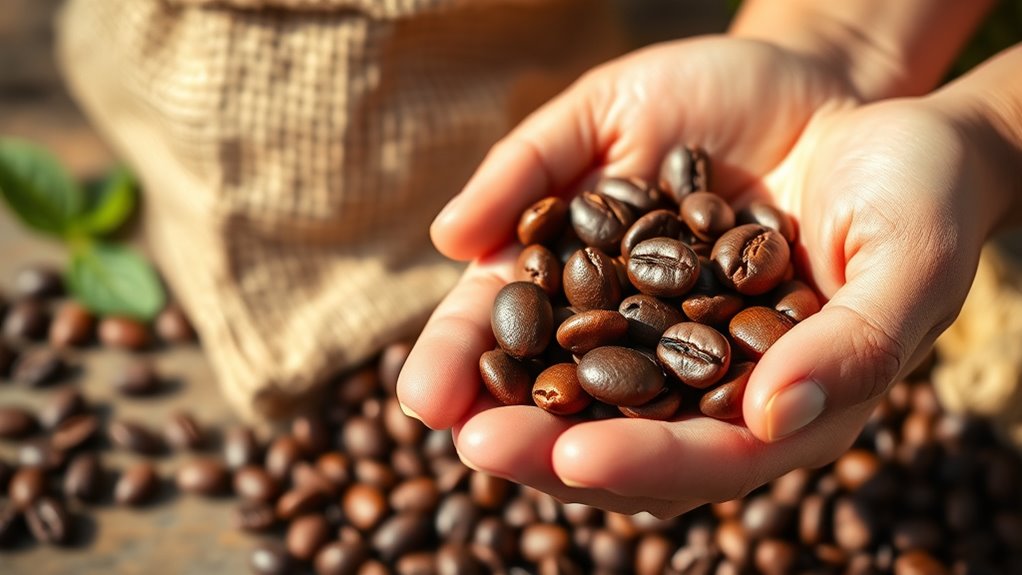To select high-quality coffee beans, look for beans with vibrant aroma, even color, and no defects or mold. Choose beans from reputable sources like direct trade or certified brands, and prefer Arabica for better flavor. Pay attention to the region, as stable climates and good cultivation practices influence quality. Freshly roasted beans stored properly stay flavorful longer. If you keep exploring, you’ll discover more tips to pick the best beans for your taste.
Key Takeaways
- Choose beans with high SCA scores (80+), indicating premium quality and consistent flavor profiles.
- Opt for Arabica beans grown at high elevations in volcanic or loamy soils for richer aroma and taste.
- Check for uniform size, color, and density; intact, defect-free beans ensure better flavor and freshness.
- Consider the processing method—washed beans offer bright, acidic flavors, while natural processing yields fruity, full-bodied profiles.
- Store beans in airtight containers in cool, dark places and consume within 4-6 weeks of roasting for optimal freshness.

Choosing high-quality coffee beans begins with understanding the different types and what sets them apart. Arabica and Robusta are the primary varieties, each offering distinct characteristics. Arabica beans dominate the premium market because they deliver smooth, sweet flavors with complex aroma profiles like floral, citrus, or chocolate notes. They grow best at higher altitudes, typically between 900 and 2,000 meters, where slower cherry maturation develops richer flavors.
High-quality Arabica, especially specialty-grade beans scoring 80 or above on the SCA’s 100-point scale, are carefully cultivated in ideal conditions, including volcanic or loamy soils with good drainage, stable temperatures, and partial shade. This combination produces beans with uniform size and shape, dense structure, and consistent color, all vital for even roasting and extraction.
High-quality Arabica beans thrive in volcanic or loamy soils with stable temperatures and partial shade.
In contrast, Robusta beans thrive at lower elevations, are more resistant to pests and diseases, and tend to have harsher, more bitter flavors with higher caffeine content. While Robusta is often used in blends or instant coffee, it generally lacks the nuanced aroma and flavor complexity of Arabica.
When selecting high-quality coffee beans, pay close attention to their sensory characteristics. Premium beans exhibit a rich aroma composed of floral, citrus, chocolate, or fruity scents, signaling freshness and quality. The flavor should strike a balance among acidity, sweetness, and bitterness, avoiding harsh or sour notes.
Good beans deliver a clean, velvety mouthfeel with a lingering aftertaste, often described as smooth or well-rounded. Bright, wine-like acidity, such as that found in Kenyan coffees, indicates a superior quality, especially when the beans are defect-free, with no moldy, sour, or fermented flavors.
The physical attributes of the beans matter too; look for uniform size and shape, consistent color (medium to dark green when unroasted), and high density, which signifies beans grown at higher elevations. The beans should be intact, with minimal cracks or holes, and moisture content should be around 10-12% to prevent staleness or mold growth.
Growing conditions dramatically influence bean quality. Select beans harvested from regions with stable climates and well-managed shade, which prevents overripening and pest issues. Hand-picking ensures only ripe cherries are selected, avoiding under- or overripe beans that could compromise flavor.
Multiple passes during harvesting guarantee uniform ripeness, while post-harvest sorting removes debris and defective beans immediately. Processing techniques also shape the final quality; washed processing produces bright, acidic profiles, while natural or honey processes yield fruity, full-bodied flavors.
Proper storage is essential; keep beans in airtight containers in cool, dark environments below 25°C, and consume within 4 to 6 weeks of roasting to preserve freshness. Additionally, proper drying techniques help prevent mold and preserve bean quality during storage.
Finally, choosing brands with SCA certification or those practicing direct trade can offer additional assurance of quality, traceability, and fair compensation for farmers.
Frequently Asked Questions
How Does Altitude Affect Coffee Bean Quality?
Altitude influences coffee bean quality by extending the growth and ripening period, which increases bean density and flavor complexity.
When you grow coffee at higher elevations above 1200m, you’ll notice pronounced floral and fruity notes, along with vibrant acidity.
Cooler temperatures and volcanic soils enhance mineral content.
Beans from these heights develop harder structures, often classified as “strictly hard bean,” indicating superior quality and richer flavors.
What Are the Best Storage Methods for Fresh Beans?
When it comes to keeping your coffee beans at their best, you’re aiming for a cozy, undisturbed sanctuary. Store them in a dark, cool spot away from heat sources and humidity.
Use airtight, opaque containers—vacuum-sealed if possible—that protect against light and oxygen.
Handle them minimally, transferring to fresh containers, and grind only when you’re about to brew.
Regularly clean your storage to preserve their vibrant flavor over time.
How Do Processing Methods Influence Flavor?
Processing methods directly influence your coffee’s flavor. Wet processing makes your brew bright, clean, and fruity with a crisp acidity.
Dry processing adds sweetness, body, and complex notes like chocolate and berries.
Honey processing balances fruity sweetness with smoothness.
Carbonic maceration enhances floral and fruity flavors through fermentation.
Your choice of method shapes the overall taste profile, acidity, and body, giving you a variety of unique coffee experiences.
What Certifications Indicate High-Quality Beans?
Certifications are like a badge of excellence, signaling high-quality beans. Look for Q Certified or Specialty Coffee Association (SCA) certifications, which guarantee top flavor and quality standards.
Organic, Bird-Friendly, and Rainforest Alliance also indicate beans grown sustainably and with attention to detail. Fair Trade and UTZ certifications show social responsibility, while third-party audits verify compliance.
These markers help you select beans that are both flavorful and ethically produced.
How Can I Tell if Beans Are Ethically Sourced?
You can tell if beans are ethically sourced by checking for certifications like Fair Trade, Rainforest Alliance, or Organic. These labels guarantee fair wages, environmental sustainability, and eco-friendly farming practices.
Also, look for transparency in payments and direct trade relationships, which support farmers’ autonomy and community projects. When you buy from brands that prioritize traceability and partnerships, you’re supporting ethical practices throughout the supply chain.
Conclusion
Choosing high-quality coffee beans is like planting seeds of passion in your daily routine. When you select the best, you’re nurturing more than just flavor—you’re cultivating moments of joy and connection. Let each sip symbolize a journey, a reminder that quality and care transform an ordinary morning into something extraordinary. So, embrace this mindful choice, and let your coffee experience bloom into a symbol of appreciation for life’s simple, yet profound, pleasures.








